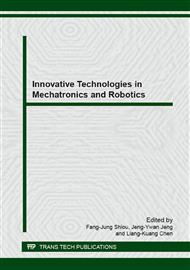p.9
p.14
p.22
p.30
p.38
p.46
p.54
p.60
p.66
A Study of Cutting Temperatures in Turning Carbon-Fiber-Reinforced-Plastic (CRFP) Composites with Nose Radius Tools
Abstract:
Nine kinds of chamfered main cutting edge nose radius tools were used in turning of high-strength carbon-fiber-reinforced-plastics (CFRP) materials to study the cutting temperature of tip's surface. A new cutting temperature model using the variations of shear and friction plane areas occurring in tool nose situations are presented in this paper. The frictional forces and heat generated in the cutting process are calculated by using the measured cutting forces and the theoretical cutting analysis. The heat partition factor between the tip and chip is solved by using the inverse heat transfer analysis, which utilizes temperature on the K type carbide tip’s surface measured by infrared as the input. The tip’s carbide surface temperature is determined by finite element analysis (FEA) and compared with temperatures obtained from experimental measurements. Good agreement demonstrates the proposed model.
Info:
Periodical:
Pages:
38-45
Citation:
Online since:
June 2015
Authors:
Price:
Сopyright:
© 2015 Trans Tech Publications Ltd. All Rights Reserved
Share:
Citation:


